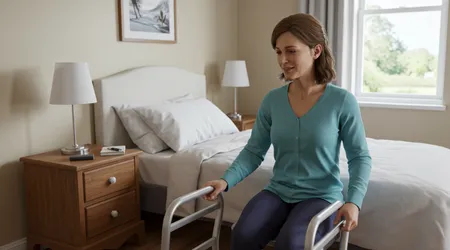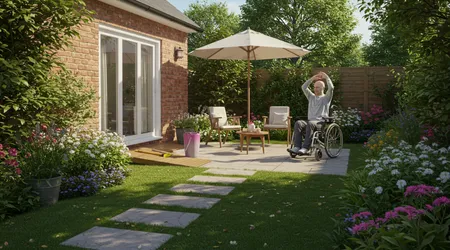Morning Routines for People with Mobility Challenges

Morning routines for people with mobility challenges are more than a checklist; they’re a foundation for independence, comfort, and empowerment.
For those navigating physical limitations, mornings can set the tone for the entire day, influencing mood, productivity, and well-being.
Unlike generic routines, these need careful customization to address unique mobility needs while fostering autonomy.
In 2025, advancements in assistive technology and a growing focus on accessibility have made it easier to craft morning routines that are both practical and uplifting.
This article explores how to design morning routines for people with mobility challenges that are flexible, efficient, and aligned with individual needs, drawing on real-world insights and practical strategies.
Why settle for a one-size-fits-all approach when you can create a morning that truly works for you?
The importance of a tailored morning routine cannot be overstated. For someone with mobility challenges, tasks like getting out of bed or preparing breakfast can require extra time, energy, or tools.
A well-designed routine mitigates these hurdles, turning potential frustrations into manageable steps.
According to a 2023 study by the National Institute on Disability, Independent Living, and Rehabilitation Research, 68% of individuals with mobility impairments reported improved quality of life when using structured daily routines.
This statistic underscores the transformative power of intentional planning.
By integrating accessibility-focused strategies, morning routines for people with mobility challenges can enhance independence and reduce stress.
This guide dives into practical, innovative ways to structure mornings, from adaptive tools to time-saving techniques.
We’ll explore how to prioritize tasks, leverage technology, and create a supportive environment, all while keeping the process engaging and human-centered.
Whether you’re adapting to new mobility challenges or refining an existing routine, these insights will help you start the day with confidence.
Understanding Mobility Challenges in Morning Routines
Mobility challenges vary widely, from temporary injuries to chronic conditions like cerebral palsy or arthritis.
Each person’s needs shape their morning routines for people with mobility challenges.
For example, someone using a wheelchair may need a clear path to the bathroom, while another with limited hand dexterity might struggle with buttons.
Understanding these nuances is the first step to crafting an effective routine.
Consider Sarah, a 34-year-old with multiple sclerosis. Mornings were once exhausting due to muscle stiffness, but she now uses a bedside grab bar to ease transfers.
++ How to Create a Sensory-Friendly Living Room
This small adjustment saves energy for other tasks. Identifying specific barriers like tight spaces or complex tasks allows for targeted solutions that make mornings smoother.
Another key factor is energy management. Fatigue often compounds mobility issues, so routines must balance effort and rest.
For instance, breaking tasks into smaller steps can prevent burnout. By mapping out challenges, you can design morning routines for people with mobility challenges that feel intuitive and empowering.

Adaptive Tools and Technology for Morning Ease
Innovative tools have revolutionized morning routines for people with mobility challenges.
In 2025, smart home devices like voice-activated assistants streamline tasks like turning on lights or adjusting thermostats.
For example, Alexa can control a coffee maker, saving someone with limited arm strength from manual operation.
Consider adaptive clothing, like magnetic-closure shirts, which simplify dressing for those with dexterity issues.
Read more: Accessibility in Grocery Stores: What Needs to Change
John, a 50-year-old stroke survivor, uses these to dress independently, boosting his confidence.
Similarly, transfer boards help wheelchair users move from bed to chair with less strain. These tools turn daunting tasks into manageable ones.
| Tool | Purpose | Example Use |
|---|---|---|
| Grab Bars | Support for transfers | Assists in moving from bed to chair |
| Voice-Activated Assistant | Control home devices | Turns on lights or coffee maker |
| Magnetic-Closure Clothing | Simplify dressing | Eases buttoning for limited dexterity |
| Transfer Board | Safe bed-to-chair transitions | Reduces physical strain |
Smart beds with adjustable heights are another game-changer. They allow users to align with wheelchairs, reducing fall risks.
By integrating such tools, morning routines for people with mobility challenges become less physically taxing and more autonomous.
The rise of wearable tech, like smart braces, also aids mobility. These devices provide real-time feedback on posture or movement, helping users pace themselves.
For someone with arthritis, this can prevent overexertion during morning stretches, ensuring a safer start.
Structuring Your Morning for Efficiency
Efficiency is critical in morning routines for people with mobility challenges. Start by prioritizing tasks based on energy levels.
For example, showering might come after medication when stiffness is reduced. This strategic sequencing conserves energy and reduces frustration.
Time-blocking is another effective approach. Allocate specific windows for tasks like dressing or eating, factoring in rest breaks.
For instance, 15 minutes for grooming with a five-minute pause can prevent fatigue. This method keeps the morning predictable yet flexible.
Batch similar tasks to streamline effort. Preparing breakfast and taking medication can happen in the kitchen, minimizing movement.
By organizing tasks thoughtfully, morning routines for people with mobility challenges become less chaotic and more achievable.
Another tactic is pre-planning the night before. Laying out clothes or prepping breakfast ingredients saves time and energy.
For someone with limited grip strength, pre-sliced fruit or easy-open containers make a big difference, enhancing morning flow.
Visual schedules can also help. A simple chart outlining tasks in order like brushing teeth, then dressing provides clarity.
This structure empowers users to navigate morning routines for people with mobility challenges with less mental strain.

Creating an Accessible Home Environment
An accessible home is the backbone of effective morning routines for people with mobility challenges.
Clear pathways are essential remove rugs or clutter to ensure safe navigation. For wheelchair users, a 36-inch-wide hallway is ideal for smooth movement.
Install lever-style door handles instead of knobs for easier gripping. In the bathroom, a roll-in shower with a bench enhances safety and comfort.
These modifications create a space where tasks like brushing teeth or washing up feel less daunting.
Lighting matters, too. Bright, motion-sensor lights reduce the need to fumble for switches, especially for those with limited reach.
An accessible environment supports morning routines for people with mobility challenges by minimizing physical barriers.
Strategic furniture placement also helps. Keep essential items, like medications or phones, within arm’s reach from the bed.
For example, a nightstand with a charging dock ensures devices are accessible without stretching, streamlining the morning.
Small tweaks, like lowering shelves or using pull-out drawers, further enhance accessibility.
These changes allow someone with mobility challenges to retrieve items independently, fostering a sense of control and easing morning tasks.
Mindset and Motivation: Starting the Day Right
A positive mindset fuels morning routines for people with mobility challenges.
Begin with a moment of gratitude perhaps reflecting on a small win, like a restful night. This mental reset can boost resilience for the day ahead.
Visualization is another powerful tool. Picture completing tasks smoothly, like transferring to a wheelchair with ease.
This mental rehearsal, akin to an athlete preparing for a race, builds confidence. For someone with mobility challenges, it can make daunting tasks feel achievable.
Incorporate affirmations tailored to personal goals. Saying, “I am capable of starting my day with strength,” reinforces self-belief.
Pairing this with a favorite song can create an uplifting morning vibe, energizing the routine.
Engage with a supportive community, even virtually. A quick text to a friend or joining an online group for people with mobility challenges can spark motivation.
Connection fosters a sense of belonging, enhancing morning momentum.
Self-compassion is equally vital. If a task takes longer than planned, acknowledge the effort rather than focusing on speed.
This mindset shift transforms morning routines for people with mobility challenges into opportunities for growth and empowerment.
Incorporating Self-Care and Wellness
Self-care is a cornerstone of morning routines for people with mobility challenges.
Gentle stretching, tailored to one’s abilities, can improve circulation and reduce stiffness. For example, seated yoga poses can be done from a wheelchair, promoting flexibility.
Hydration is another key element. Keeping a water bottle with a straw nearby simplifies drinking for those with limited grip.
Starting the day with water supports overall health and energy, crucial for tackling morning tasks.
Mindfulness practices, like a five-minute breathing exercise, can reduce anxiety.
Apps like Calm offer accessible guided sessions, adaptable for various mobility levels. These moments of calm ground the morning, enhancing focus and well-being.
Nutrition also plays a role. A balanced breakfast, like a smoothie with pre-blended ingredients, is easy to prepare and digest.
For someone with mobility challenges, this ensures energy without requiring complex cooking.
Journaling can round out self-care. Writing one thing you’re looking forward to each morning fosters positivity.
This practice, even if brief, integrates seamlessly into morning routines for people with mobility challenges, nurturing mental health.
Overcoming Common Morning Hurdles

Mornings can bring unique obstacles for those with mobility challenges, but strategic planning can help.
Fatigue, a common issue, can be managed by pacing tasks. For instance, sitting while brushing teeth conserves energy for later activities.
Pain or stiffness often peaks in the morning. Using a heating pad before moving can loosen joints, making transfers easier.
This small step can transform the start of morning routines for people with mobility challenges into a more comfortable experience.
Unpredictable symptoms, like muscle spasms, require flexibility. Have backup plans, like pre-made breakfasts, for tough days.
This adaptability ensures the routine remains functional, even when challenges arise unexpectedly.
External support can also help. A caregiver or family member might assist with heavy tasks, like lifting a wheelchair.
Coordinating their help early aligns with the flow of morning routines for people with mobility challenges, reducing stress.
Technology can address hurdles, too. Smart pill dispensers with alarms ensure medications are taken on time, even if memory or dexterity is an issue. These solutions keep mornings on track, no matter the challenge.
Conclusion: Crafting a Morning That Empowers You
Morning routines for people with mobility challenges are about more than tasks they’re about reclaiming control and starting the day with purpose.
By blending adaptive tools, thoughtful planning, and a positive mindset, you can create a routine that feels uniquely yours.
From smart home devices to accessible environments, 2025 offers countless ways to make mornings smoother and more empowering.
What’s stopping you from designing a morning that sets you up for success?
This guide has unpacked practical strategies, from leveraging technology to prioritizing self-care, all grounded in real-world examples like Sarah’s grab bar or John’s adaptive clothing.
These tools and approaches aren’t just conveniences they’re lifelines that foster independence.
By addressing specific challenges and incorporating wellness, morning routines for people with mobility challenges become a powerful tool for daily triumph.
Take the first step today: assess your current routine, identify one small change, and try it tomorrow.
Whether it’s a new tool or a mindset shift, every adjustment brings you closer to a morning that works for you.
With intention and creativity, your mornings can become a source of strength, not struggle.
Frequently Asked Questions
Q: How can I make my morning routine faster if I have mobility challenges?
A: Prioritize tasks, use adaptive tools like transfer boards, and pre-plan the night before to streamline effort and save time.
Q: What’s the best way to stay motivated during tough mornings?
A: Start with a positive affirmation or a quick mindfulness exercise, like deep breathing, to boost resilience and set an uplifting tone.
Q: Are there affordable tools for improving morning accessibility?
A: Yes, options like grab bars or magnetic-closure clothing are cost-effective and widely available, enhancing independence without breaking the bank.
Q: How do I adapt my routine for unpredictable symptoms?
A: Build flexibility with backup plans, like pre-made meals, and use smart tools like pill dispensers to maintain consistency despite challenges.
